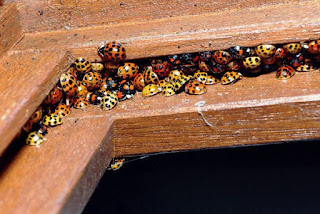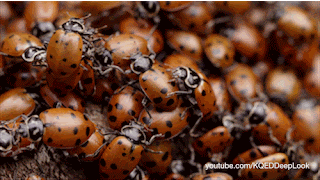First, let’s get down to the naming thing (which, for some reason, many people get hung up on): Asian Lady Beetles and what we call ladybugs are both members of the insect family Coccinellidae. All members of this family are beetles, what we call them is simply a reflection of where we come from. In the US they are ladybugs; in the UK they are ladybirds and various places know them as lady beetles. Asian Lady Beetles can be referred to as a Harlequin Ladybugs/Ladybirds as well. So, any and all of these are species of one family, no matter what name you give them.
While what we know as ladybugs are very recognizable in their bright red and black spotted shells, Asian Lady Beetles wear a huge variety of different colors and markings. The white marking found at the base of the head (it looks like an “M” or a “W”) can be a good way to identify these insects, but not all of them have it. Asian Lady Beetles, which can have spots, no spots, or even stripes, have an orange and black color palette as opposed to the red and black of ladybugs.Many people point to two things that set Asian Lady Beetles apart from ladybugs - that they bite/are aggressive and that they smell. Both of these assertions are a bit hyperbolic.
Yes, Asian Lady Beetles have pincers and can bite when disturbed, but they do not attack. And their pincers are tiny, so their bite can’t really harm a person. However, some people do have an allergic reaction to the bite that can cause everything from cough to hives. People who are sensitive to these creatures may not even need to be bitten, touching a beetle then touching one’s eye has been known to cause pink eye.
Asian Lady Beetles are often said to have a noxious odor. While they do secrete a goo that has an unpleasant odor when disturbed, this behavior is common throughout the ladybug world. It’s a defense mechanism known as reflex bleeding and is meant to discourage predators. The excretions of Asian Lady Beetles may be particularly gross to many people, but they no worse (or no better) than other ladybugs. That said, their particular goo is known to stain surfaces like walls, furniture, or fabrics. This all becomes a problem only when they begin to gather in large numbers, particularly inside structures.
As winter approaches in temperate climates, Asian Lady Beetles begin to aggregate in ever-growing clusters to keep warm and seek out winter quarters. This is usually when they come into conflict with people because they tend to like the snug shelters that humans have made (why they choose human habitats is still under debate, this article gives some explanation). Once the beetles have chosen a spot to overwinter, they send out a pheromone trail that attracts others to their spot. This is why hordes of insects “suddenly” appear. These scent trails can last years, meaning some homes experience invasions every year.
Take Care
Submitted by Pam











No comments:
Post a Comment